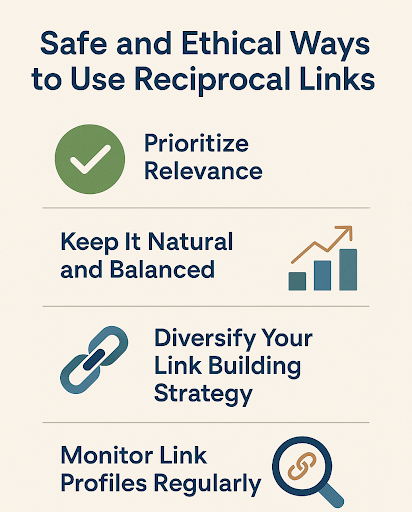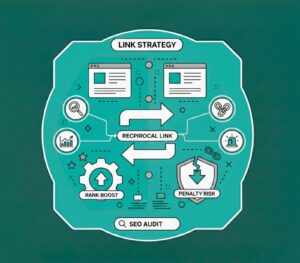Reciprocal Links in SEO: Do They Still Boost Rankings or Risk Penalties?
Blogs | Category
Written By: Lauren Davison
Introduction
“Should we still trade links?” It’s a familiar itch, a relic that hangs around like an old reflex from the early SEO era. Reciprocal links SEO once felt child-simple: you point at me, I nod back. Game over.
These days? Google is sharper, twitchier, and occasionally paranoid about why you’re linking at all. The act itself isn’t the villain; the story behind it is. Some brands handle it like grown-ups, part of a wider, thoughtful link-building mix, while others push too hard and stumble straight into the penalty pile.
If you’re still chewing on whether reciprocal linking is clever, careless, or just a shruggy “depends,” you’re in the right place. We’ll explore how the practice has evolved, the weird grey areas, and the ethics behind reciprocal linking best practices, and whether it still earns a seat in your SEO toolkit in 2025.
Table of Contents
What Are Reciprocal Links in SEO?
Simple Definition
A reciprocal link is the mutual linking of two websites, where A links to B and B links back to A. It’s an old-school idea: “I’ll help your visibility if you help mine.” When both links are editorial, relevant, and genuinely useful to readers, they’re normal parts of the web graph. When they’re arranged as a group for ranking gains, they look like schemes.
How It Used to Work
Back in the early 2000s, search engines leaned heavily on raw link counts. Webmasters traded links in directories, exchanged footer links, and joined link farms. Those swaps quickly moved the needle because quantity was a dominant ranking signal. The path was simple and mechanical: swap links → more inbound links → higher rankings.
How Google’s Algorithm Changed the Game
Google’s Penguin family of updates shifted the paradigm: link quality, context, and naturalness matter far more than sheer counts. Penguin’s goal was to detect link manipulation and either discount or penalise those signals.
This makes manipulative reciprocal networks far less effective and more likely to harm rankings. Over time, Google has refined how it identifies and treats unnatural link patterns, favouring editorially earned links.
Do Reciprocal Links Still Work in Modern SEO?
When They Can Be Beneficial
Reciprocal links provide value when they arise from genuine relationships and user-first contexts:
- Trusted partners and collaborators: Two brands that co-create a piece of content or co-sponsor research naturally link to each other within helpful, contextual copy.
- Resource-sharing: Academic citations, industry alliances, and product integrations sometimes create mutual links that are perfectly reasonable.
- Complementary content: If Site A’s how-to complements Site B’s toolkit and each link genuinely helps a reader, the link is editorial, not an exchange.
When reciprocal links are contextual and scarce, they add referral traffic, credibility, and, occasionally, incremental authority. But crucially, they shouldn’t look like they exist primarily for SEO.
When They Can Be Risky
Reciprocal linking becomes risky when the arrangement is transactional, large-scale, or irrelevant:
- Mass exchanges and link farms – If dozens or hundreds of sites trade links with the express aim of manipulating rankings, those patterns are detectable and harmful.
- Irrelevant linking – Links with mismatched topics or audiences dilute user value and scream “unnatural.”
- Identical anchor text patterns and repeated swaps – Repetition is a fingerprint of manipulation.
Google’s public guidance explicitly discourages excessive link exchanges and labels them as potential link schemes; treat them cautiously.
How Google Evaluates Reciprocal Links Today
Focus on Link Quality and Context
Modern ranking systems evaluate links for editorial intent, relevance, and placement. A link embedded naturally within useful content passes a different signal than a footer or profile link placed as part of an exchange.
Google’s updates over the years have emphasised that links should be earned, not bought or bartered. When assessing reciprocal links, ask: Would an independent reader find this link helpful? If yes, it’s safer. If not, it’s risky.
Signals That Indicate Manipulation
Some red flags search engines look for include:
- Repeated, identical anchor text across many exchanged links.
- An unusually high proportion of reciprocal links from low-quality domains.
- Quick bursts of reciprocal link acquisition that don’t align with editorial activity.
Those signals can mean links are being engineered, not earned.
Impact on Authority and Rankings
If reciprocal links are a minor, organic part of a diverse backlink profile, they’re unlikely to harm authority. If they’re a large share, however, link equity can be diluted and trust signals weakened. Sometimes links are discounted entirely, and in severe cases, manual action can follow. That’s why monitoring and balance are essential.
Safe and Ethical Ways to Use Reciprocal Links
1. Prioritise Relevance
Only exchange links with sites whose content naturally connects to yours. If you run a cooking site, linking to a finance blog in exchange for a link back is likely irrelevant and potentially risky.
Practical tip: ask whether the link improves a user’s journey on the page. If the answer is “no,” don’t do it.
2. Keep It Natural and Balanced
Reciprocal links should be a small percentage of your inbound links. A natural backlink profile includes a majority of one-way editorial links, citations, and earned mentions. If your backlink audit shows reciprocal links clustering at the top, rethink the approach.
Real-world guardrail: aim for reciprocal links to be a single-digit percentage of your referring domains; there’s no universal rule, but err on the side of scarcity.
3. Diversify Your Link Building Strategy
Don’t rely on exchanges. Mix in guest posts, digital PR, resource pages, how-to guides, and community participation. Use partnerships to co-create content where mutual links are a byproduct of genuine collaboration rather than the objective.
4. Monitor Link Profiles Regularly
Use Google Search Console and a backlink tool such as Ahrefs, SEMrush, or Moz to watch for spikes, repeated anchors, and suspicious patterns. Regular audits let you spot harmful reciprocal clusters early and either remove links or deny when necessary.
Alternatives to Reciprocal Linking
You don’t need reciprocal links to build authority. Here are safer, higher-ROI alternatives.
Create Link-Worthy Content
Original research, long-form guides, tools, and interactive assets earn links naturally. This is slow but sustainable: high-quality content invites citations without negotiation.
Leverage Partnerships for Co-Authored Content
Co-author reports, webinars, or case studies with partners. Those collaborations naturally lead to contextual mentions instead of transactional swaps.
Build Community Relationships
Becoming a visible, helpful presence in niche communities, industry forums, and conferences leads to organic mentions and links from trusted sources.
Case Study — Reciprocal Links Done Right
Imagine two niche SaaS companies that integrate:
Company A writes a detailed help article on integrating partner products, embedding a contextual link to Company B’s integration page.
Company B publishes a case study that cites Company A’s implementation guide and links back inside the narrative.
Why this works: the links are embedded in user-centric content, they improve support and discovery, and they naturally belong to the context. Transparency (clear disclosures of partnership when appropriate) and user value keep the exchange editorial, not transactional.
Expert Insights — What SEOs Say in 2025
The Consensus
Most seasoned SEOs agree: reciprocal links aren’t intrinsically bad; manipulative reciprocal linking is. The modern emphasis is on intent and organicness. Trusted sources and recent analyses highlight that reciprocal linking can be part of a broader outreach palette but should never be the backbone of a link-building strategy.
Future Outlook
As ranking systems absorb richer machine learning and user-behaviour signals, link quality and context will eclipse raw volume. The links that actually help real people, and arrive from credible, topically aligned sources, will keep their weight.
Search engines, quieter than you’d think, are sharpening their ability to recognise footprints of manipulation. Scale-driven reciprocal schemes wobble under that scrutiny. Expect future evaluations to lean harder on intent, contextual fit, and the subtle engagement cues that show whether a link was earned or engineered.
Conclusion — Quality Over Quantity, Always
Reciprocal links SEO isn’t quite a fossil, though the old game of casual swapping for quick wins has mostly burned out. These days, mutual backlinks can still carry weight, but only when they’re earned, relevant, and pleasantly rare. The guiding instinct stays blunt: think about real people first, spread your link building across multiple paths, and keep an eye out for odd patterns lurking in your backlink graph.
If you want a practical route, one that respects Google’s signals and actually moves the needle, partner with people who treat links as signals of real value, not as trophies. That’s what Midland Marketing does: contextual link approaches, transparency up front, and measurable outcomes.
Need a quick health check of your backlink profile or a plan to replace shaky swaps with durable, editorial mentions? We will audit, advise, and co-create the content that earns links naturally. Contact us for a pragmatic, ethical link strategy.
Frequently Asked Questions
What are reciprocal links?
Essentially, two sites agree to reference each other; a trade of mentions meant to share audience, credibility, and SEO lift.
Can reciprocal links help my SEO?
Sometimes, when relevance is high and swaps are scarce. Done right, they send referral visits, support trust, and lightly bolster domain authority overall.
What are the risks of reciprocal linking?
Overdoing it, swapping with off-topic sites, or joining link circles can spark penalties and bruise rankings.
How does Google view reciprocal links now?
Google watches context, anchor patterns, and intent; sloppy exchanges bleed authority and may trigger quiet filtering today.
What’s the best alternative to reciprocal linking?
Craft standout resources, co-write with partners, and show up in communities where sincere conversation earns natural backlinks.


Written by - Lauren Davison
Introducing Lauren – one of our content writers who has a flair for SEO and creative strategy!
With a Master’s Degree in Creative Writing, Lauren has niched down into SEO and content writing.
Outside of work, she loves watching the darts, reading and the pub on the weekend.
Want some more?
Latest Insights & News

Reciprocal Links in SEO: Do They Still Boost Rankings or Risk Penalties?
For the keyword “reciprocal links SEO,” focus on explaining how reciprocal linking works today. Reciprocal links are not harmful by default, but Google can flag excessive or manipulative link exchanges. To stay safe, only exchange links when they are contextually relevant, natural, and valuable to users.

SEO as the Foundation of Digital Growth: Why It’s More Than Just a Marketing Tactic
When focusing on “SEO for business growth,” highlight how SEO directly contributes to long-term scalability. Modern SEO goes beyond ranking—it boosts brand visibility, qualified traffic, customer trust, and conversion opportunities. To optimize effectively, ensure your content covers user intent, builds topical authority, and leverages technical SEO elements like fast loading, mobile-friendly design, and structured data.

AEO Mastery: Step-by-Step Guide to Building AI Citations & Boosting Visibility
When targeting the keyword “AEO Guide to Building AI Citations & Boosting Visibility,” focus on Authoritative Engine Optimization (AEO) principles. AI-driven search requires clear, structured, and entity-rich content.
